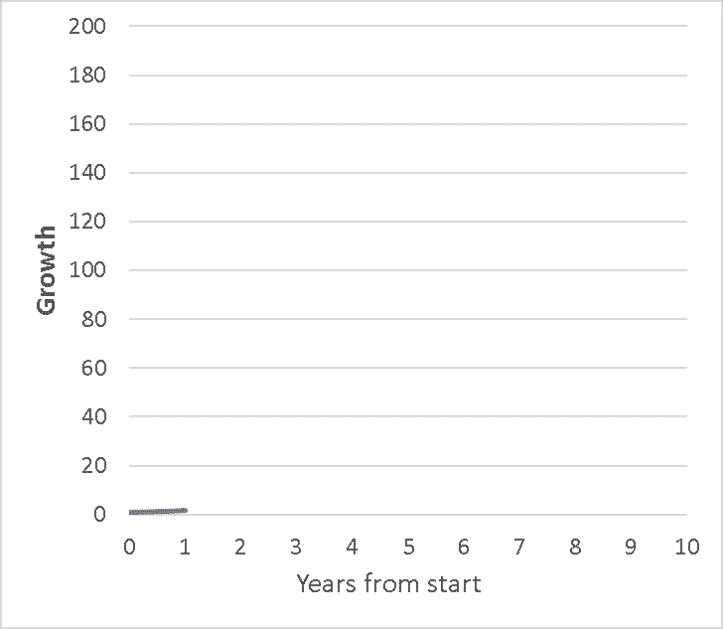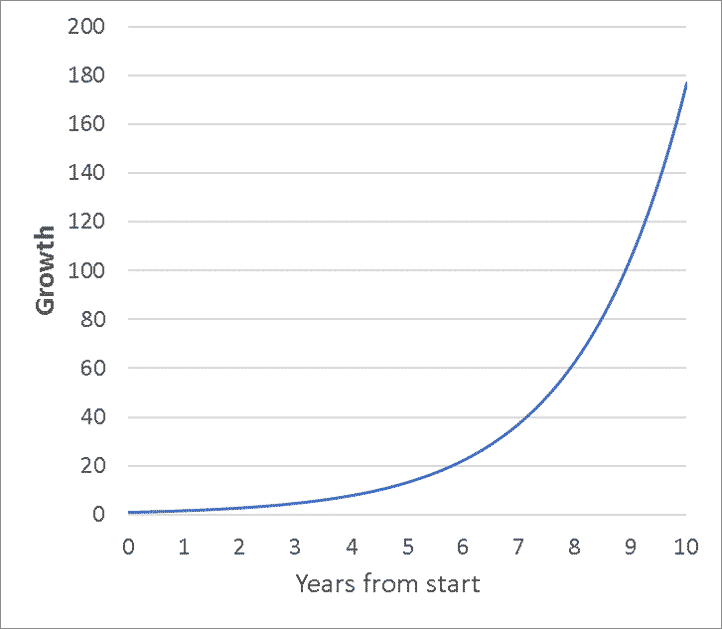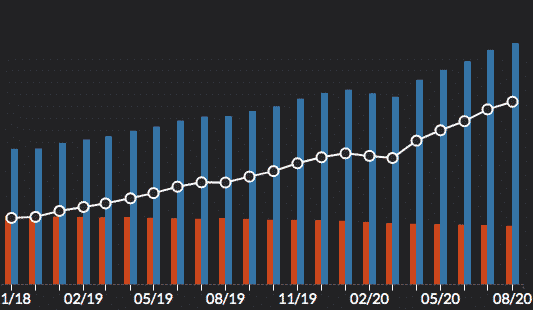Today’s simple graphics will enlighten you on the power of baby steps and the potency of small repeated marginal gains.
A Baby’s Growth
It’s easy to overlook the rapid growth that humans undergo.
At first, we’re a helpless whiny lump that’s capable of only three things: eat, sleep, bathroom. This baby, one might assume, must have a pretty low ceiling.
Fast forward two full years and…ok, some progress has happened. Our baby is now zooming around of her feet, and she’s babbling, and she’s feeding herself, albeit poorly. These are some true baby steps. Small progress. But this is largely still a helpless child.

By age five, she’s talking. That’s cool. She can eat food without spilling, she can read (whoa!), and she can run around. Compared to an adult, she’s small and weak and dumb (sorry, it’s true!). But there’s been fantastic progress.
I won’t go much further. We know that brains and bodies continue to grow into adulthood. And we know that adult humans are capable of amazing accomplishments. But the path from helpless whiny lump to amazing adult—that path was walked one baby step at a time.
Let’s bring back Wallace
Remember Wallace from “The Best Time to Invest?”
He’s back, and he’s trying to improve himself via a similar baby step method. What’s he improving?
It could be anything, financial or otherwise. Perhaps Wallace wants a fully funded emergency fund. He wants to eat a healthier diet. Or maybe he wants to be a better writer.
I’m going to refer to these improvements as levels. Wallace is at Level 1 right now. He’s a whiny helpless lump, but he’s looking to grow.
Wallace is going to focus on building towards his goals using a simple 1% improvement every week. Whatever the goal, whatever the skill. Wallace’s wants to take baby steps of 1% improvement each week.
Wallace’s will improve from 1.00 to 1.01 in Week 1.
And then he’ll improve from 1.01 to 1.021 in Week 2.
Slowly but surely, Wallace will progress. His level will improve.
Enjoying this article? Subscribe below to get new articles emailed straight to your inbox
But baby steps are slow
Baby steps are slow. And that’s why baby step improvements can be frustrating (at least for adults—not so much for babies). Take a look at Wallace’s first year of progress. It’s that little blue streak at the bottom of the plot.

Whether he’s saving money or writing a blog or improving at chess, Wallace has barely made any progress (at least, based on my chosen Y-axis).
But Wallace is a grinder. He believes in the power of baby steps. So he continues to focus on weekly 1% improvements for two more years.

Ok! At least Wallace’s growth is no longer looking like a flat line. Let’s fast forward another couple years.

Wallace hits the curve
After five years, it’s apparent that Wallace is starting to “hit the curve.” His 1% improvements no longer look like a straight line. Instead, those improvements are building on one another in a compounding manner.
When he started, Wallace was at “Level 1.” His 1% improvement was tiny—1% of 1 is 0.01. But after hundreds of 1% improvements, he’s now around Level 13. The 1% improvements now increase his level by 0.13 each week. In ~6 weeks of Year 5, Wallace grows more than he did the entire Year 1.
All styles of exponential growth exhibit this behavior. Growth compounds on growth. The early steps feel slow, barely making progress. The last steps feel monumental. But those monumental steps wouldn’t have been possible without the years of slow progress beforehand.
Many 4-year olds can’t read, but many 9-year olds can read chapter books. Five years of consistent practice can bring a sea change of improvement.
It’s just like the parable of rice filling up a chessboard.

The curve continues to steepen through Year 10. Now at level 177, the idea of being at level 1 is a distant memory for Wallace. It’s just like the idea that “a lot can change in ten years.”
But are baby steps always possible?
I’ve shown you an assumed scenario where Wallace is always able to make 1% improvements. And maybe that’s too ambitious of an assumption.
Even if Wallace hits the top of his game—like Lebron, Adele, or Meryl Streep—he will probably hit some sort of plateau. You can’t necessarily get better forever. But the goal doesn’t need to be infinite growth. Instead, the goal is to find an effective mindset to achieve growth. And that’s what the baby step method provides.
A widely shared story of baby steps involves coach Dave Brailsford’s leadership of the British Cycling team.

Brailsford’s vision expanded beyond training and racing and physical attributes. Instead, Brailsford wanted to improve every aspect of a cyclist’s life—diet, sleep, even relationships. Of course, it included their training and recovery and equipment, too. Brailsford was thinking about baby steps. If he could find 70 different places to make a 1% improvement, the cyclists would end up 100% better (1.01 ^ 70 = 2). Sounds easy, right?
They bought more comfortable pillows to help the cyclists sleep through the night. They cut out refined foods, replacing them with something nutritious. The team considered every component on the bicycle where mass could be reduced, even if only by a gram.
These small improvements worked wonders.
Under Brailsford’s leadership from 2007 to 2017, British cyclists won 5 Tour de France titles. And they won 66 Olympic or Paralympic gold medals. Oh, and they won 178 world championships. British cycling dominated the world cycling scene.
Baby steps work.
Baby steps in personal finance
There are plenty of opinions about simple financial goals that you can add to your baby step to-do list.
Unburying yourself—from debt, from bad habits, etc.—isn’t a one step process. It takes time. And it requires small improvements. You know—baby steps.
You can earn money in bits and pieces. A little raise here, a side hustle there. You can get paid to read books or use smartphone apps that pay you money. Little baby steps all over.
College loans and mortgages can take decades to repay. Learning a new budgeting system requires patience. The math behind interest rates might take a few attempts to understand. Rome wasn’t built in a day. And your personal finance success will take time too. But it’ll come if you stick with it.

This plot shows the small baby steps I’ve made over the past two years. In blue are my slow and steady investments. In red is my slow and steady debt payoff. And the white circles combine the two to show a steady increase in net worth.
Winning the lottery would be cool. So would investing in next Amazon, Apple, etc. while they’re still a startup. But if I don’t get that lucky, I’ll be ok. My baby steps are slowly building up.
Keep on Growing
Thank you for reading! If you enjoyed this article, join 8000+ subscribers who read my 2-minute weekly email, where I send you links to the smartest financial content I find online every week.
-Jesse
Want to learn more about The Best Interest’s back story? Read here.
Looking for a great personal finance book, podcast, or other recommendation? Check out my favorites.
Was this post worth sharing? Click the buttons below to share!
kudoooos on the latest readership milestone and blog honors, Jess!
Thanks Alonzo! Im so glad you’re a reader here 🙂